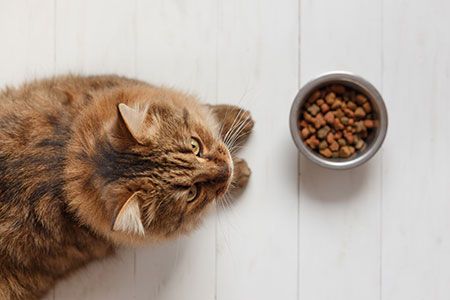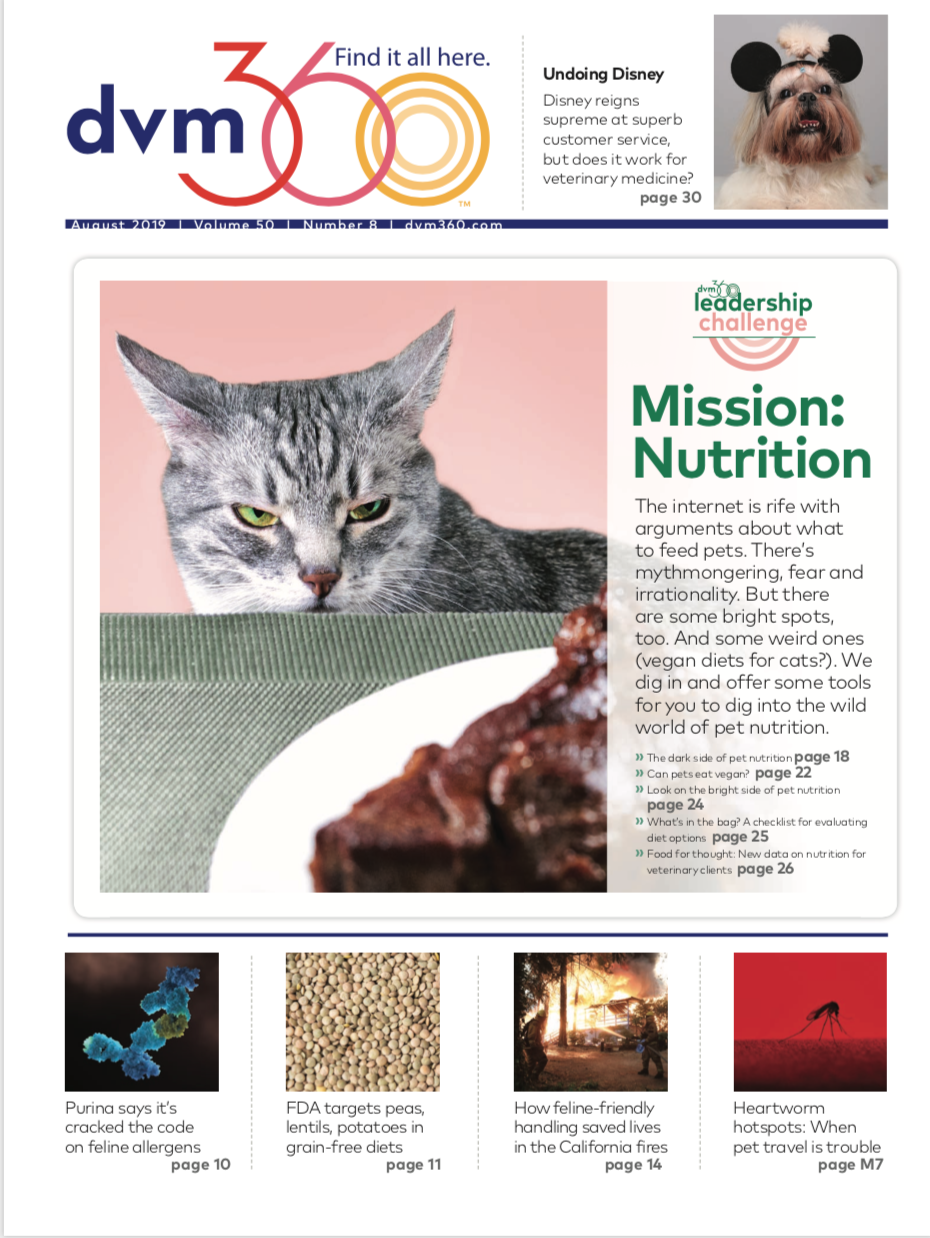Take the offensive with patients fighting cancer and inappetence
An untouched food bowl is bad for patient health and client perceptions. Heres how to partner with pet owners to catch and control inappetence in your veterinary oncology patients.
vladdeep / stock.adobe.com

It's easy to be judgmental about pet owners-especially ones like Jeter's.
At presentation, the then 10-year-old cat had lost almost a third of his body weight. Jeter's owner wasn't even the first to notice. The owner's mother-in-law had brought it to her attention while visiting over the Thanksgiving holiday.
Weight loss wasn't the cat's only sign, however. Jeter had also been vomiting, but because he lived in a multicat household, his owner made excuses that intermittent vomiting was normal. The internist at our practice diagnosed him with inflammatory bowel disease (IBD).
Like I said, it's easy to be judgmental. I mean, who lets their pet lose so much weight?
Apparently I did. Jeter was my cat, and I'm married to the aforementioned internist who diagnosed him. Two boarded specialists were blind to the signs that my mother-in-law noticed in an instant. The experience was a humbling reminder of how difficult it can be for pet owners to detect weight loss in their own pets, regardless of their day jobs.
After five years of successfully managing his IBD, Jeter's disease progressed to lymphoma and I took over his oncologic care. I could handle prescribing his chemotherapy, but I struggled with managing his inappetence.
Because prolonged inappetence can become even more detrimental to the patient than the underlying disease, and because appetite can be a crucial element in the pet owner's perception of the patient's quality of life (i.e. an eating pet is a happy pet), our oncology patients need us to become proactive instead of reactive. We must work to discover and treat the underlying cause(s), and we must educate pet owners on the signs so the issue doesn't go undetected.
Cause and effect
Inappetence can be the first (and sometimes only) sign that a pet is ill. The causes can be divided into three categories:
CINV: A dreaded side effect
Chemotherapy-induced nausea and vomiting (CINV) is a common side effect of chemotherapy treatment in both human and veterinary medicine. CINV will sometimes lead pet owners to stop their pet's chemotherapy, so it's important to be on the offense-especially in chemotherapy patients that present with vomiting or inappetence before treatment begins.1 This is most often seen with gastrointestinal lymphoma, where common clinical signs from the neoplasia itself are GI related. Concurrent medical conditions can also contribute to and exacerbate CINV, such as nasal cancer, renal disease, pain and medications like opioids and nonsteroidal anti-inflammatory drugs. Additional preventive medications are imperative in these patients.
Reference:
1. Johannes CM. Clinical impact and management of chemotherapy-induced vomiting and inappetence, in Proceedings. ACVIM Forum, 2017
> True inappetence can have physical (e.g. an inability to smell), neurologic (e.g. damage to the appetite center), environmental (e.g. moving to a new home, hospital stay) and psychological (e.g. fear) causes.
> Secondary inappetence can be caused by medications such as chemotherapy and opioids, pain, nausea, respiratory distress, neurologic disease and systemic disease.
> Pseudoinappetence can stem from oral disease, dysphagia, food aversion and an unpalatable diet.
Clinical signs of inappetence include decreased food consumption, weight loss, muscle wasting, lip smacking, vomiting, poor hair coat and behavior changes. The most common behavior change reported by my clients is the pet approaching the bowl as if hungry and then turning away without eating. As I've discovered firsthand, these signs can be difficult to recognize by both pet owners and veterinary professionals.
Consequences of inappetence include weight loss, cachexia, metabolic derangements and delayed wound healing, as well as decreased immune response, strength, gastrointestinal mucosal function and survival time.1-3
Mitigating medications
Here are the three most common medications I prescribe for my inappetent oncology patients:
Capromorelin oral solution (Entyce-Aratana Therapeutics) is indicated for the stimulation of appetite in dogs (though it can be used off label in cats at lower doses). As a ghrelin receptor agonist, capromorelin mimics the action of the hunger hormone ghrelin, which triggers appetite stimulation and growth hormone secretion. It's been shown to increase food intake and weight gain in both dogs and cats and has demonstrated a wide margin of safety.4,5
I find it helpful to use capromorelin with maropitant (Cerenia-Zoetis) in inappetent patients when it's unclear whether nausea is contributing to the inappetence. I recommend using both for a minimum of two days and then continuing with capromorelin. (More on maropitant below.)
More from Dr. Sue Ettinger
They don't call her “Dr. Sue Cancer Vet” for nothing. Find more of her expert oncological guidance here, including an article on conquering mast cell tumors.
Mirtazapine transdermal ointment (Mirataz-KindredBio) is the first and only FDA-approved transdermal product for weight loss management in cats.
Mirtazapine is a 5-HT3 receptor antagonist with appetite stimulant properties. Oral mirtazapine is used as an antidepressant in people, and increased appetite and weight gain are among its common (though not well understood) side effects. It's also regularly used as an appetite stimulant in dogs and cats, but oral administration can be a challenge for many cat owners.
Data has shown that mirtazapine transdermal ointment is safe and results in weight gain in both normal cats and cats with underlying disease.6 It represents another option for cats with cancer and other diseases causing inappetence and weight loss.
I find it helpful to use mirtazapine transdermal ointment with maropitant in cats that aren't eating when it's unclear whether nausea is contributing to the inappetence. This approach has been especially helpful for cats with gastrointestinal lymphoma.
Maropitant is a neurokinin-1 receptor antagonist that acts in the central nervous system by inhibiting substance P, the key neurotransmitter involved in vomiting. Maropitant suppresses both peripheral and centrally mediated emesis and has been shown to be effective for controlling vomiting secondary to a variety of stimuli (including reducing CINV).7,8 Some dogs and cats with cancer may benefit from chronic maropitant therapy, as controlling CINV can be a relentless challenge.
Partner with pet owners
On the first day of chemotherapy, all my patients go home with maropitant, metronidazole, a probiotic and a client information sheet that walks pet owners through what to look for and how to manage side effects at home. I give pet owners an overview of what the sheet contains so they know when and how to use it when they're on their own. If the patient is inappetent before starting chemotherapy or if I'm prescribing antibiotics or pain medications, I will also add capromorelin oral suspension for dogs and mirtazapine transdermal ointment for cats. (You can check out two YouTube videos I made on the subject here and here.)
Despite the recent emergence of more effective antiemetics and inappetence medications, inappetence remains a challenge. But as I mentioned earlier, the efforts I've described aren't meant to merely prevent the patient from enduring the detrimental effects of inappetence. Their other, equally important goal is to preserve the pet owner's perception that their pet has a good quality of life.
References
- Forman MA. Anorexia. In: Ettinger SJ, Feldman EC, eds. Textbook of Veterinary Internal Medicine. Vol 1. 7th ed. St. Louis: Elsevier, 2010;172-174.
- Zoran DL. Nutritional management of gastrointestinal conditions. In: Ettinger SJ, Feldman EC, eds. Textbook of Veterinary Internal Medicine. Vol 1. 7th ed. St. Louis: Elsevier, 2010;676-681.
- Satyaraj E. Emerging paradigms in immunonutrition. Top Companion Anim Med 2011; 26(1):25-32.
- Zollers B, Wofford JA, Heinen E, et al. A prospective, randomized, masked, placebo-controlled clinical study of capromorelin in dogs with reduced appetite. J Vet Intern Med 2016;30(6):1851-1857.
- Wofford JA, Zollers B, Rhodes L, et al. Evaluation of the safety of daily administration of capromorelin in cats. J Vet Pharmacol Ther 2018;41(2):324-333.
- Poole M, Quimby JM, Hu T, et al. A double-blind, placebo-controlled, randomized study to evaluate the weight gain drug, mirtazapine transdermal ointment, in cats with unintended weight loss. J Vet Pharmacol Ther 2019;42(2):179-188.
- Rau SE, Barber LC, Burgess KE. Efficacy of maropitant in the prevention of delayed vomiting associated with administration of doxorubicin to dogs. J Vet Intern Med 2010;24(6):1452-1457.
- Vail DM, Rodabaugh HS, Conder GA, et al. Efficacy of injectable maropitant (Cerenia) in a randomized clinical trial for prevention and treatment of cisplatin-induced emesis in dogs presented as veterinary patients. Vet Comp Oncol 2007;5(1):38-46.
Suggested reading
- Gustafson DL, Page RL. Cancer chemotherapy. In: Withrow SJ, Vail DM, Page RL, eds. Small Animal Clinical Oncology. 5th ed. St. Louis: Elsevier, 2013;157-179.
- Rodriguez CO. Chemotherapy. In: Henry CJ, Higginbotham ML, eds. Cancer Management in Small Animal Practice. Saunders 2010;101-121.
Dr. Sue Ettinger is a practicing veterinary cancer specialist, international speaker, book author and vlogger. Also known as Dr. Sue Cancer Vet, she is the co-author of the second edition of The Dog Cancer Survival Guide.
